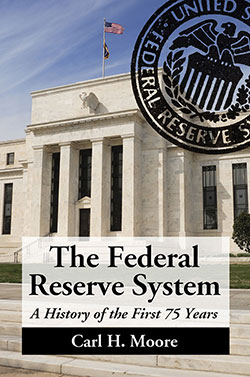The Federal Reserve System
A History of the First 75 Years
Original price was: $29.95.$23.99Current price is: $23.99.
In stock
About the Book
For more than 100 years since its inception, the United States struggled through a variety of financial problems, crises, and would-be solutions to the problems of currency, credit and financial stability. On December 23, 1913, Woodrow Wilson signed into law the Federal Reserve Act, creating an institution patterned after the central banks of Europe yet still uniquely American. This is a complete revelation of the workings of the system—the early history, organization, leadership, evolution and development, and major figures. Appendices include the original Federal Act (not readily available elsewhere) and numerous reference tables covering 1914–1989.
About the Author(s)
Bibliographic Details
Carl H. Moore
Format: softcover (6 x 9)
Pages: 280
Bibliographic Info: 14 photos, map, glossary, appendices, bibliography, index
Copyright Date: 2011 [1990]
pISBN: 978-0-7864-6735-8
eISBN: 978-0-7864-8761-5
Imprint: McFarland
Table of Contents
Acknowledgments xi
Preface xiii
1. The Climax of a Long Struggle 1
Authorship of the Act 2
First United States Bank 3
Problems Persisted 4
Check Collection a Problem 5
A Search for Solutions 5
Democrats Come to Power 5
Ideas Sharply Divided 6
A Quick Summary of the Act 7
Federal Advisory Council 8
2. Getting Organized 10
How Many Fed Banks? 10
Subscribing Capital Stock 10
Hurry Up! 11
Preliminary Organization Committee 12
Surveying Opinions 13
Local Issues Important 13
Decision Time 15
Everyone Happy? No Way! 15
Naming the Federal Reserve Board 18
Politics Again 21
War Breaks Out 21
Fed Bank Directors 24
Open the Banks! 26
The “League” 28
3. Open for Business (1914–1919) 29
Who’s in Charge? 30
Changes in District Boundaries 32
How Can We Make A Profit? 33
A Wartime Atmosphere 34
Gold Settlement Fund 34
A New Currency—Federal Reserve Notes 35
Bank Reserves 37
Setting the Discount Rate 38
A Discount Policy 39
Check Clearing 40
Par Clearance of Checks 41
World War I and the Fed 43
United States Declares War 45
What Role for Gold? 47
A Glance into the Future 48
Governors’ Conference 48
Revisions of the Act Needed 49
A New Task for the Fed 52
Leadership in the Early Years 52
Does the Public Like the Fed? 56
4. A Struggle for Leadership (1920–1929) 57
Where Was the Fed? 57
The Phelan Act 58
No Firm Policy 59
Some Positive Facts 61
Speculation on the Rise 62
Internal Problems at the Fed 63
Politics Erupts 64
A Change in Mood 64
A Problem with Gold 65
Storage of Gold 65
Beginning of Open Market Operations 65
Markets Fall Apart 66
A Time for Action 67
“Tools” of the Fed 70
Leadership at the Fed 71
Day-to-Day Operations at Fed Banks 72
What about Par Banks? 73
Operations during the Decade of the 1920s 74
Legislation 74
5. A Decade of Change (1930–1939) 75
Where Was the Fed? 76
Looking Back 76
How to Handle a Run on Your Bank 77
What Action Should the Fed Have Taken? 78
Roosevelt Elected President 79
The Crisis Had Been Building 79
A New Face at the Fed 84
The Banking Act of 1933 87
Reserves for Feds Suspended 88
The Banking Act of 1935 88
What Fed Policy Now ? 90
Fed Gets a New Home 91
Meanwhile in the Back Rooms of the Feds 92
6. World War II and Its Aftermath (1941–1950) 94
What Role for the Fed? 94
Credit Controls 95
Peace Arrives 96
Now Let’s Deal with Inflation 96
A Change of Presidents 96
Unexpected Support for the Fed 97
Fed Makes a Formal Policy Statement 98
Another Side to the Fed 99
Federal Reserve Bulletin Born 100
Don’t Forecast! 102
How Much Does It Cost? 102
Work Increases at Fed Banks 105
7. The Fed Comes into Its Own (1950–1959) 108
What Was the Accord? 109
Enter Congressman Partman 112
Refining “Independence” 112
Power of the Fed Recognized 113
Challenges within the System 114
Chairman Martin and Washington Politics 115
Behind the Scenes at FOMC 117
The “Desk” 119
Operational Studies in the System 122
What to Do with All Those Checks 122
Counting All That Money 124
Changing Role of the Discount Window 126
Looking Back 128
8. The Public Discovers the Fed (1960–1969) 130
The Fed’s Role 131
Politics as Usual Again 132
Fed’s Independence Challenged Again 133
Problems with Currency 134
Greater Problems with Coin 135
News on the International Front 135
A Substitute for Gold? 136
9. The Soaring Seventies (1970–1979) 139
A New Style of Leadership at the Fed 139
Difficult Economic Problems 140
Congress Wants to Know NOW 141
Evasive Action by the Fed 141
Let the Sunshine In? 142
How about a GAO Audit? 144
Chairman Burns Calls in the Reserves 144
Leadership Changes Again 145
Another First at the Board 145
Increasing Importance of International Factors 146
The Consumer Demands Attention 147
Bank Operations Changing Too 148
Changes Outside the Fed 148
Remote Disbursements a Problem 149
What Can the Fed Do? 151
More Buildings Needed 152
10. Another Banking Evolution (1980–1989) 153
Welcome, Paul Volcker 153
A “Warm” Welcome for the New Chairman 154
Inflation Slowed 155
Major Changes for the Fed and the Banking Industry 156
Changes Welcomed by Consumers 158
Impact on the Fed 159
The Fed Adjusts 160
Daylight Overdrafts 160
Remote Disbursements—A New Check Collection Problem 161
Consumers and the Fed 162
International Developments 163
Legislation 164
Volcker Leaves the Fed 164
A Look Back 168
Appendixes 171
Glossary 171
Copy of Original Federal Reserve Act 173
Commercial Banks Certifying to the Organization of Each Federal Reserve Bank 203
Governors and Directors of Each Federal Reserve Bank, 1914 204
Design of the First Federal Reserve Notes 207
Federal Reserve Banks and Branches, 1989 209
Map o Federal Reserve Districts, 1989 210
Members of the Federal Reserve Board and the Board of Governors with Federal Reserve District of Residence and Term of Service 212
Board of Governors and Official Staff, 1989 214
Federal Open Market Committee, 1989 216
Board of Governors Advisory Councils, 1989 216
Principal Officers at Federal Reserve Banks, 1914–1989 217
Principal Officers at Federal Reserve Banks and Branches, March 1989 223
Number of Officers and Employees at Each Federal Reserve Bank, 1915–1988 224
Number of Employees at Federal Reserve Board and the Board of Governors by Selected Years 224
Sample of a Directive to the Manager of the Trading Desk From the Federal Open Market Committee 225
Discount Rate at the Federal Reserve Bank of New York, 1914–1989 226
United States Marketable Securities and Related Data, 1915–1988 228
Commercial Bank Suspensions, 1892-1988 229
Number of Commercial Banks in U.S., Total Assets, Number of Banks Member of the Federal Reserve System and Related Data, 1915-1988 230
Gold: World Production and Stock Held by United States, 1914–1986 232
United States Federal Debt, 1916-1987 233
Description of Federal Reserve Districts, 1917 234
Income and Expenses of Each Federal Reserve Bank, 1914–1988 238
Statement of Condition as of the End of the Year for Each Federal Reserve Bank, 1914, 1920,1930, 1940, 1950, 1960, 1970, 1980 and 1988 242
Bibliography 261
Index 263
Book Reviews & Awards
“for…readers interested in a general survey of the Federal Reserve history”—Choice.





